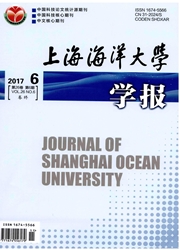

 中文摘要:
中文摘要:
采用豆油和菜籽油混合(1∶1)替代鱼油,研究了育肥饲料中不同鱼油替代水平对中华绒螯蟹(Eriocheir sinensis,简称河蟹)生殖性能、卵径、单卵质量和胚胎生化组成的影响。实验分为5组,饲料1#~5#鱼油替代水平分别为0、25%、50%、75%和100%。每个饲料组设置3个重复,每个重复放入雌蟹和雄蟹各25只,养殖60 d后进行交配试验,比较其生殖性能和胚胎生化组成。结果表明:(1)饲料3#组雌蟹在交配后第10天开始抱卵,其余组均在第15天开始抱卵,饲料1#、3#和5#组的最终抱卵率均为100%,而2#与4#组抱卵率为80%左右;饲料4#的产卵量、生殖力和生殖指数略高于其他各组,但各组间均无显著差异(P〉0.05)。(2)就胚胎质量而言,饲料1#组的卵径相对较大,但各饲料组的卵径、单卵湿重和干重的差异均不显著(P〉0.05)。(3)各饲料组胚胎中的水分、粗蛋白、粗脂肪和脂肪酸组成均无显著差异(P〉0.05),22∶6n3含量呈下降趋势,18∶2n6和∑n-6PUFA/∑n-3PUFA呈上升趋势。因此,育肥饲料中采用豆油和菜籽油混合替代鱼油,投喂性腺发育中期的河蟹,对其生殖性能、胚胎质量及生化组成均没有显著影响,育肥饲料75%左右的鱼油替代水平可以适当提高其产卵量和生殖力。
 英文摘要:
英文摘要:
This study was conducted to investigate the effects of different fish oil replacement levels on reproductive performance, egg diameter, individual egg wet weight and dry weight, proximate composition and fatty acid composition in the eggs produced by Chinese mitten crab (Eriocheir sinensis).Five isonitrogenous and isolipidic fattening diets were formulated by the blending vegetable oils(soybean oil∶ rapeseed oil =1∶1) to replace 0, 25%, 50%, 75% and 100% of fish oil(defined as feed 1#, 2#, 3#, 4# and 5#,respectively).Each experimental diet was fed to three replicates and each replicate consisted of 25 females and 25 males.After 60-day feeding, four females and two males from each replicate were randomly transferred into the brackish water tanks for the mating, and the reproductive performance and egg biochemical composition were further studied for the evaluation of effects of fish oil replacement.The results showed that: (1) Feed 3# treatment started to spawn only after 10 days of post-mating, while there were 15 days of post-mating for the other treatments;the final ovigerous rate was 100% for the treatments of feed 1#, feed 3# and feed 5#, while the final ovigerous rate of feed 2# and feed 4# was around 80%;although feed 4# treatment had the highest egg production, fecundity and reproductive effort among five treatments, no significant differences were found among the five treatments(P〉0.05).(2) As for the egg quality, feed 1# had the slightly higher egg diameter than the others,but no significant differences were found on egg diameter, individual egg wet weight and dry weight among the five treatment (P〉0.05).(3) As for the egg biochemical composition, no significant differences were found for the moisture, crude protein, crude lipid and fatty acid composition in the eggs among the five treatments (P〉0.05);the percentages of 18∶2n6, and the ratio of n-6 polyunsaturated fatty acids /n-3 polyunsaturated fatty acids (∑n-6PUFA /∑n-3PUFA) increased with inc
 同期刊论文项目
同期刊论文项目
 同项目期刊论文
同项目期刊论文
 期刊信息
期刊信息
